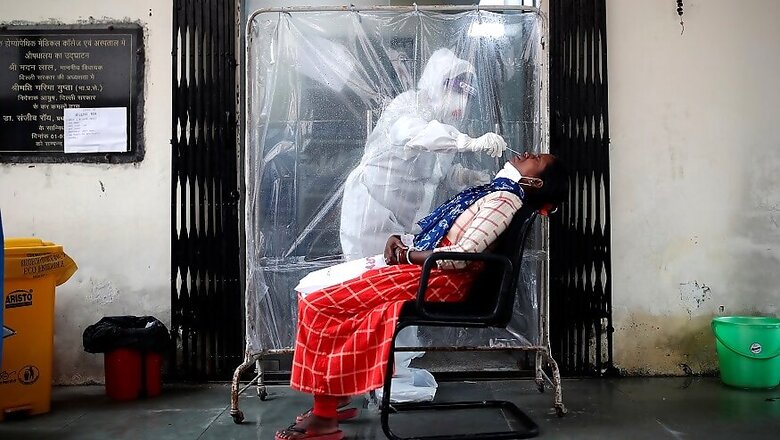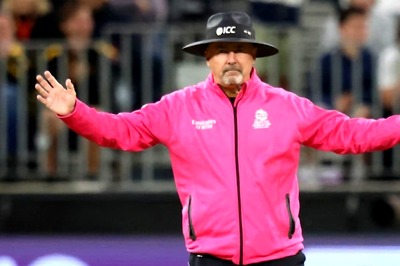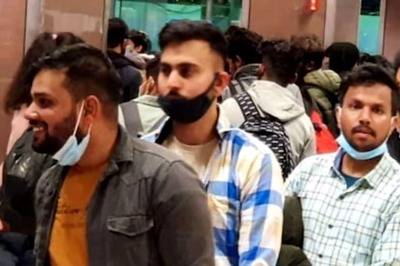
views
During a digital briefing on the coronavirus crisis, Delhi Chief Minister Arvind Kejriwal said the situation appears to be “very much under control but we cannot afford to be complacent”.
Kejriwal said that instead of the 2,25,000 projected cases and 1,13,400 active cases by mid-July, Delhi has approximately 1,15,000 positive cases of which just 18,600 were active cases.
While it was estimated that Delhi would need 34,000 beds, only 4,000 of the 15,500 available beds in hospitals and COVID-19 care centres had been occupied.
Kejriwal credited three principles in the national capital’s fight-back against the pandemic.
“The coronavirus cannot be fought alone. We could not have fought it alone. We sought help of the central government, hotels private hospitals, NGOs, religious institutions. We acknowledged weaknesses when things were going wrong and rectified them. And a ‘never say die attitude’ -- we did not accept defeat,” he said.
On May 28, Delhi, for the first time, reported more than 1,000 COVID-19 cases in a day (1,024 infections). Thirteen days later, on June 12, the capital registered a daily log of over 2,000 cases (2,137).
And six days later, Delhi crossed the 3,000 mark with 3,137 cases. On June 23, with 3947 cases, the city was a breath away from breaching the 4,000-mark.
However, since June 27, Delhi has not breached the daily case count of 3,000-mark and from June 29 onwards, except on two days, Delhi has reported under 2,500 cases. For the last five consecutive days, it has seen less than 2,000 fresh infections a day.
Fatality rate from the virus has also improved. A team appointed by the Kejriwal government to look into the causes behind the COVID-19-related deaths and suggest mitigating strategies has noted that the per day death count has come down from a high of 101 in mid-June to 46 in the last fortnight.
The case fatality rate has come down from 3.64 during the peak to 3.02%. If one were to look at only the per day cases and deaths and not an average of all the cases and deaths, the cases fatality rate would stand at an even lower 2.5%. On July 14, Delhi reported 35 deaths.
Of the 1,15,346 cases registered in the capital, 3,346 people have lost their lives so far.
The other important indicator of the improving scenario lies in the high number of recoveries. For the past eight consecutive days, the number of recoveries has outstripped the number of new cases.
Recoveries are now faster given the relaxed norms for the same. Therefore, while the cumulative in the capital has reached the 1,15,346 mark, the number of recoveries stand at a robust 93,236.
The percentage of those recovered has reached 80.83% as on July 14. The capital had recorded the highest number of active cases on June 27 at 28,329.
All of the last week of June beginning 23 till July 4, the average number of active cases crossed the 26,000 mark.
However, it started hitting the 25,000 mark since July 5. From the next day, it has shown a consistent declining trend with 25,620 active cases the same day to 18,664 active cases on July 14.
Delhi has also ramped up its testing capacity. On June 9, Delhi crossed the 10,000 tests per day mark with 13,074 tests on that day, using the rapid antigen method for the first time compared to 8,726 tests the previous day through RTPCR alone.
Since then, the capital has tested rigorously -- the highest number of per day tests was recorded on the July 4 at 23,673 with 9,925 RTPCR tests and 13,748 rapid antigen tests.
Compared to the first week of June itself, testing has shot up by three to four times in the capital. On July 14, tests per million in Delhi stood at 37,574 compared to 29,037 on July 1, 14,693 on June 15 and 10,772 on June 1.
On June 23, when the capital recorded its highest daily coronavirus cases at 3,947, the number of tests -- both RTPCR and rapid antigen stood at 16592.
The question, therefore, that arises is whether the capital has achieved its 'peak'. Dr SK Sarin, who had headed a panel appointed by the Kejriwal government in April offered an explanation.
He said, “I think peak is an area where you have the number which is maximally for a given place for at least two weeks to four weeks and it stays. You have an ascent, and the ascent has actually gone to the maximum, and then you say that there is a plateau,”
“A plateau in epidemiology is not the number of those who are infected versus recovered, but the number of new infections if they keep on adding. Plateau would mean at least stable number for the same. Reproduction number remains the same, number of infected versus number of tested. Suppose, if you are testing more versus percentage that will be fallacious. The number of tested, number of infected remains the same. I think that is a true reflection. I think Delhi, for that matter, has probably achieved it peak.
“I would say a plateau also has been there and there is a trend, but it will be the end of July before any forecast (can be made) but the crystal ball looks favourable to us,” Dr Sarin said.
Dr K Srinath Reddy of the PHFI was cautious about any final word on whether Delhi has peaked.
He said, “The trend in the decline of daily case count is a good sign. We should see the decline of the last three days is maintained over a 10-day period, since testing strategy has changed recently with a different mix of testing methods. Decline in daily death counts should also be tracked, though there will be a two-week lag time between the rates of case detection and daily deaths. These early indicators of a turnaround are encouraging, but energetic implementation of public health measures is still essential.”
Experts also pointed out that rapid antigen tests that are being conducted aggressively in every nook and corner of the city in far more numbers than RTPCR test, have certain limitations.
Dr Sarin said that only if the load of the virus is high, the rapid antigen tests will pick it up and, therefore, as many as one in five may still be missed.
While one who tests positive is a concrete case, a negative report may not be truly negative and, hence, there could be an underestimation.
Unlike earlier when Delhi used to test those who were symptomatic or lived in containment zones or high-risk groups like health workers in hospitals, now it tests even those who are asymptomatic, outside containment zones and even randomly.
According to Dr Sarin, while Delhi may be getting a lesser percentage of positive cases which may be a good sign, but it could be fallacious to some extent.
Could a declining trend also mean that more numbers in the capital could already be exposed and have developed anti-bodies?
While the result of the serological survey done by the Ministry of Health and Family Welfare, National Centre for Disease Control and the Delhi government is keenly awaited for any definitive conclusion, this could very well be the case in Delhi.
The capital was the first to go for full unlock except in containment zones, even when cases were projected to rise. Kejriwal had ruled out plans for any more lockdowns in Delhi even after a sharp upswing of cases and his own SOS to Home Minister Amit Shah on June 10.
Besides, the CM, despite disagreements with the LG and Centre over testing and reservation of beds in Delhi government hospitals only for Delhi residents, fought back fiercely to hold on to the home isolation policy even after being overturned by the central government.
As data shows, a majority of people testing positive for the virus recovered at home. Delhi was also the first to experiment and scale up plasma therapy. Locking down Delhi again was never an option.
There was perhaps also the hope that given Delhi's peculiar feature of high migrations, and density of population, the capital could move towards herd immunity.
Dr Sarin said, “Suppose I am infected, and you are exposed already but never were positive, you cannot now get infected because you have antibodies already. So as more and more people in Delhi would be exposed, we may not say community transmission, but the community has developed the immunity. Only then the decline would be a true decline, and what will happen is that the reproduction rate has to come down from 1 to 0.5 and lower. This would mean that one infected person infects only one. Earlier one infected person was infecting 2, 3 and 6 others.
“Now if the number is 2,000, it means probably the same number are getting infected. Once this number drastically comes down to half then we will say, yes the decline helps,” he said.
There are other worries of a possible second wave. The risks are already there -- when the elderly and the ones with co-morbidties who are now largely indoors, step out, when hitherto virgin territory is exposed to the virus, and also through hospitals, if the precautions are not maintained.
Dr Reddy said, “Since we have seen upswing in cases even in countries where they have claimed control, even parts of India, where it appeared where we had controlled, we must maintain our guard in Delhi and ensure that precautions are taken so that we do not see a return of large cases or deaths hereafter.
“Till the first wave ends, it will be too early to talk of a second wave. We do not know how long this epidemic is going to last and if this does subside, whether it is going to return when the weather turns cold. So, we still need to maintain every single public health measure, in full strength so that we can build up systems even if there is a second wave. We can put it down as quickly as possible,” he said.
Dr Sarin said a second wave will come. "The policies all over the world, not different in India, is a red zone or orange zone or green zone kind of thing. But if an area has never been exposed and people from there move to a place or people from where there has been high infectivity move to this place, this will always be like a new virgin land. That is what has perhaps happened in Bengaluru, Kerala and even Goa. So the virus has to come. The second peak can be in any part of the country or Delhi where the population had been totally isolated.
“I think we need to have these efforts ongoing so that no new hotspot comes up. But the second wave will come, and the WHO has said that this will stay till 2021,” he said.




















Comments
0 comment